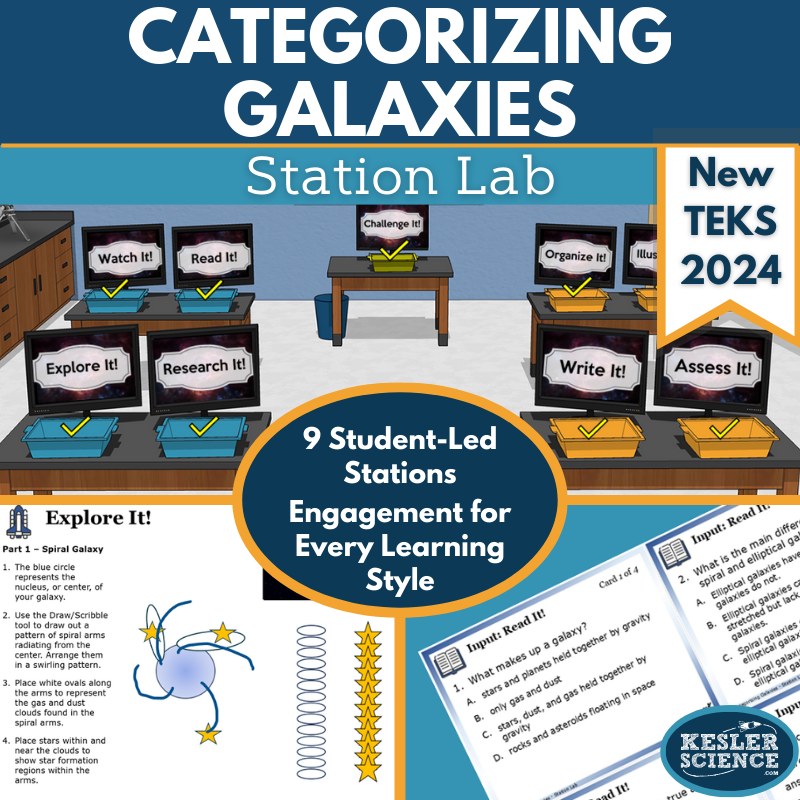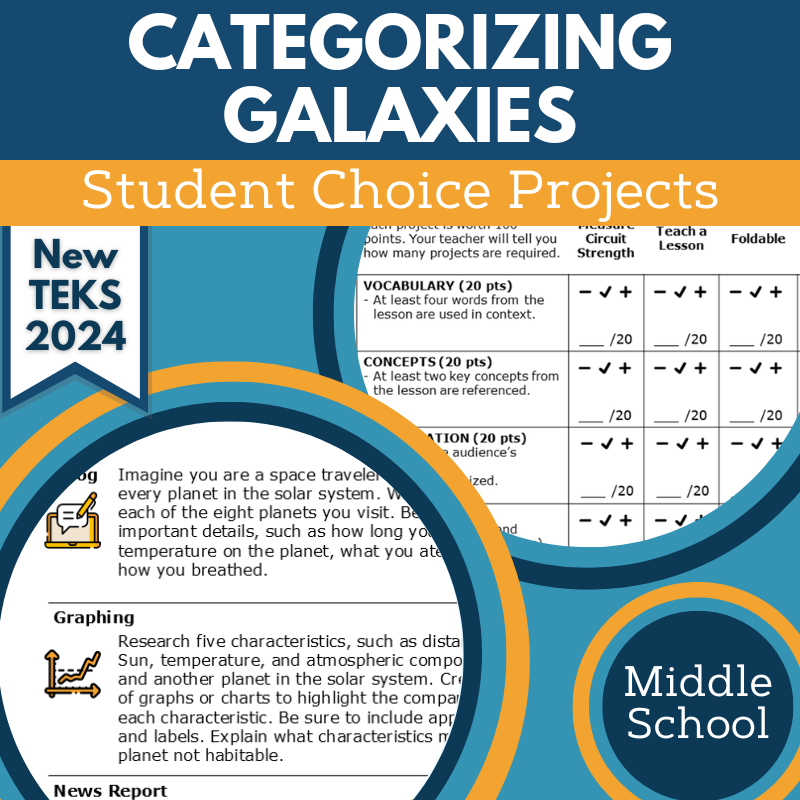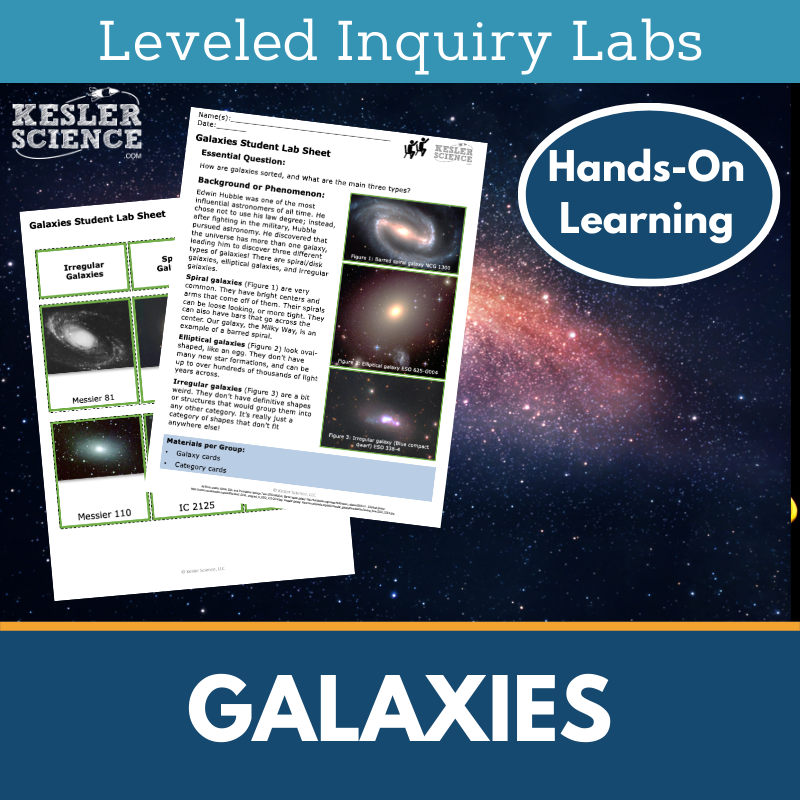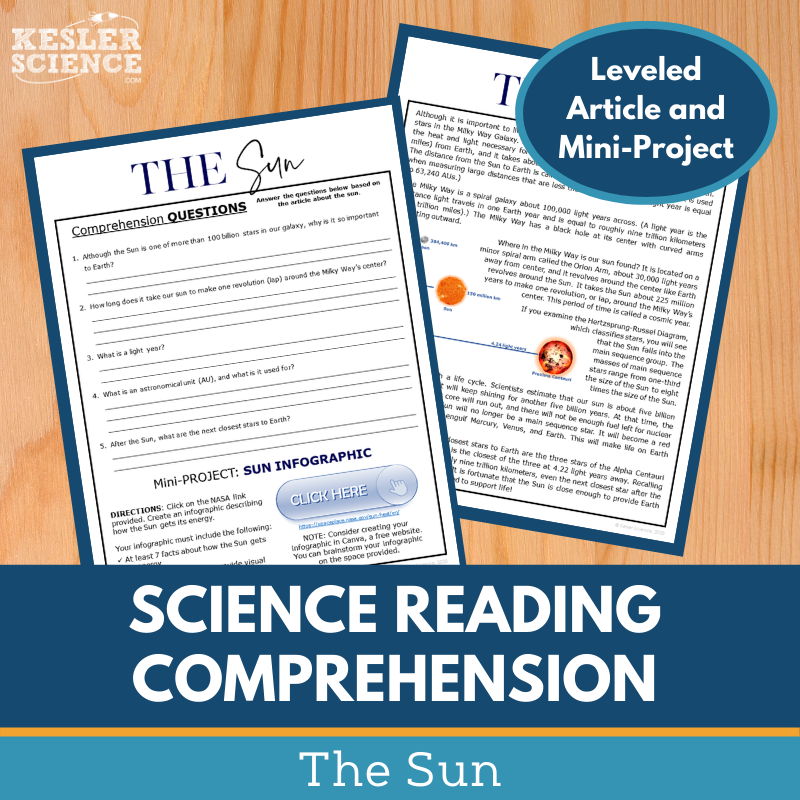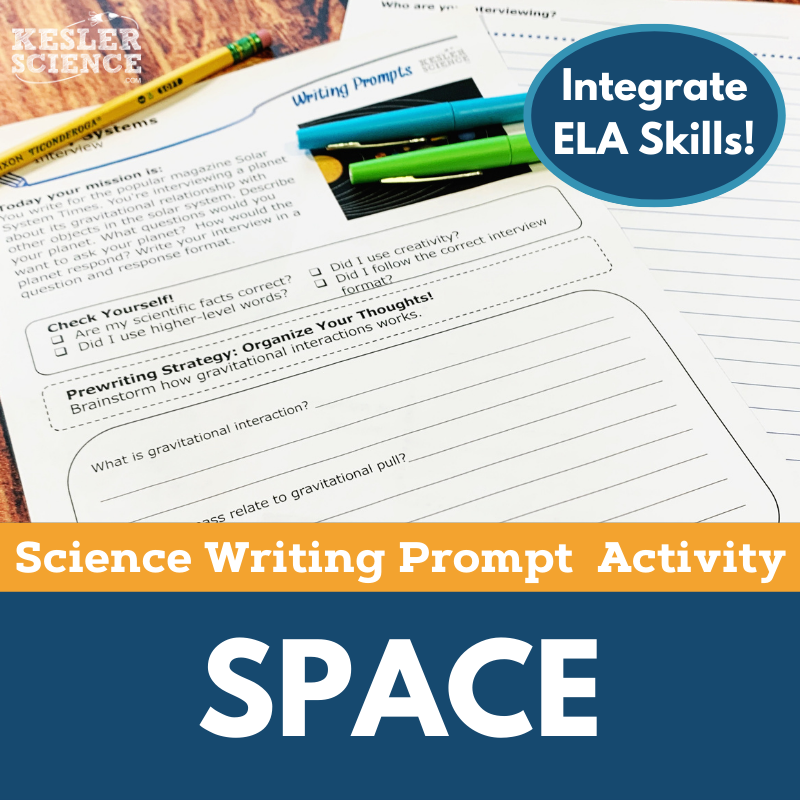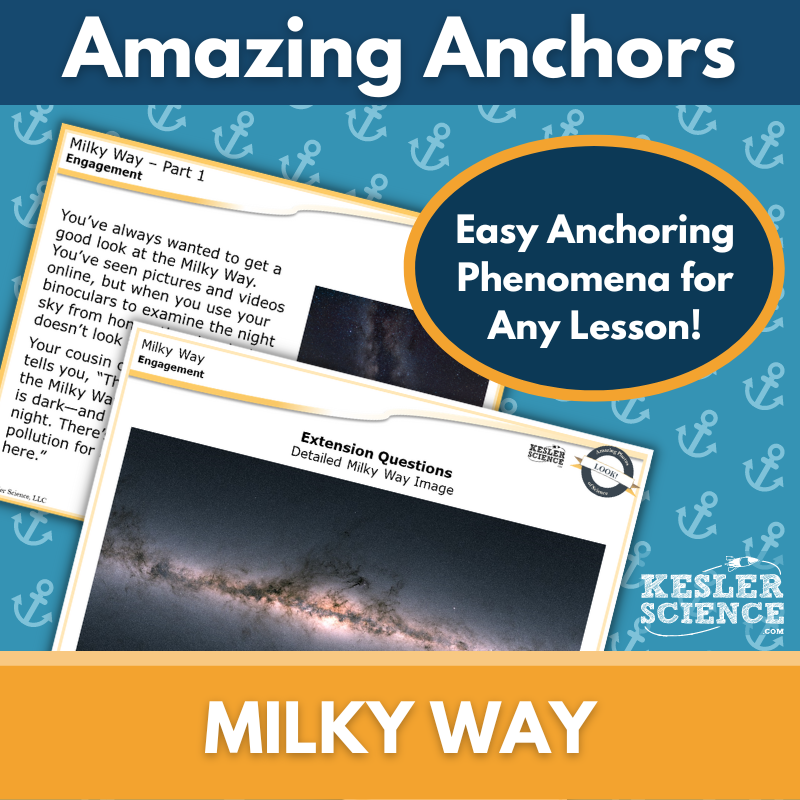Classifying Galaxies Activities for Middle School Science
Understanding galaxy classification is essential for middle school students, but it can be a challenging concept to grasp! The resources below will give students a comprehensive understanding of classifying galaxies. All of the following materials are also included in the Kesler Science Membership.
Understanding galaxy classification and Earth’s place in the Milky Way is key to middle school space science. This unit aligns with the new 2021 TEKS standards, and helps students identify spiral, elliptical, and irregular galaxies while exploring our solar system’s location. With editable PowerPoints, hands-on station labs, worksheets, and assessments, this low-prep, multi-day lesson supports differentiated, student-led learning.
Following the 5E Model, students engage with interactive exploration stations, editable presentations, and note-taking templates. The differentiated station lab includes hands-on activities, reading passages (in English and Spanish), research tasks, and videos. Choice projects and STAAR 2.0-aligned assessments help reinforce key concepts.
This lesson is flexible for in-class and virtual learning, making it easy to implement. Save 30% with the Space MS Complete Lesson Bundle (eight topics) or 35% with the MS 2024 Mega Complete Curriculum Bundle (84 topics). With engaging, well-structured content, students will gain a deeper understanding of the universe!
Understanding galaxy classification and Earth’s place in the Milky Way is key to middle school space science. This unit aligns with the new 2021 TEKS standards, and helps students identify spiral, elliptical, and irregular galaxies while exploring our solar system’s location. With editable PowerPoints, hands-on station labs, worksheets, and assessments, this low-prep, multi-day lesson supports differentiated, student-led learning.
Following the 5E Model, students engage with interactive exploration stations, editable presentations, and note-taking templates. The differentiated station lab includes hands-on activities, reading passages (in English and Spanish), research tasks, and videos. Choice projects and STAAR 2.0-aligned assessments help reinforce key concepts.
This lesson is flexible for in-class and virtual learning, making it easy to implement. Save 30% with the Space MS Complete Lesson Bundle (eight topics) or 35% with the MS 2024 Mega Complete Curriculum Bundle (84 topics). With engaging, well-structured content, students will gain a deeper understanding of the universe!
This student-led station lab on categorizing galaxies aligns with TEKS 2021 standard 8.9B and helps students classify spiral, elliptical, and irregular galaxies while locating Earth’s solar system in the Milky Way. Designed for both in-class and virtual learning, this low-prep, engaging activity encourages independent exploration and is also included in the Space Science Station Lab Bundle.
Students interact with nine modular stations, including hands-on experiments, videos, reading passages (in English and Spanish), and research activities. They demonstrate learning through organizing, illustrating, writing, and assessment tasks, with a bonus station for early finishers. This differentiated approach supports diverse learners with multiple ways to engage and apply knowledge.
This ready-to-use resource includes all task cards, signage, and digital tools, with minimal additional materials needed. Future updates will be provided, while new features will be available as separate products. Perfect for flexible, student-centered learning in any classroom!
This student-led station lab on categorizing galaxies aligns with TEKS 2021 standard 8.9B and helps students classify spiral, elliptical, and irregular galaxies while locating Earth’s solar system in the Milky Way. Designed for both in-class and virtual learning, this low-prep, engaging activity encourages independent exploration and is also included in the Space Science Station Lab Bundle.
Students interact with nine modular stations, including hands-on experiments, videos, reading passages (in English and Spanish), and research activities. They demonstrate learning through organizing, illustrating, writing, and assessment tasks, with a bonus station for early finishers. This differentiated approach supports diverse learners with multiple ways to engage and apply knowledge.
This ready-to-use resource includes all task cards, signage, and digital tools, with minimal additional materials needed. Future updates will be provided, while new features will be available as separate products. Perfect for flexible, student-centered learning in any classroom!
These Categorizing Galaxies Student Choice Projects align with TEKS 2021 standard 8.9B, allowing students to choose from six project options plus a “design your own” project. A modifiable grading rubric supports teacher, peer, or self-assessment. This resource is also included in the Categorizing Galaxies Complete Lesson.
With flexible, multimodal learning, students can demonstrate understanding creatively. The choice board includes nine projects, a teacher directions page, and editable rubrics. Student Choice Project Bundles are available, including the Space Bundle (eight topics) and MEGA Bundle (84 topics) for grades 6-8.
Projects require basic classroom supplies or can be done digitally. This ready-to-use resource will be updated as needed, with future features sold separately. Engaging and student-led, it ensures all learners can showcase their understanding!
These Categorizing Galaxies Student Choice Projects align with TEKS 2021 standard 8.9B, allowing students to choose from six project options plus a “design your own” project. A modifiable grading rubric supports teacher, peer, or self-assessment. This resource is also included in the Categorizing Galaxies Complete Lesson.
With flexible, multimodal learning, students can demonstrate understanding creatively. The choice board includes nine projects, a teacher directions page, and editable rubrics. Student Choice Project Bundles are available, including the Space Bundle (eight topics) and MEGA Bundle (84 topics) for grades 6-8.
Projects require basic classroom supplies or can be done digitally. This ready-to-use resource will be updated as needed, with future features sold separately. Engaging and student-led, it ensures all learners can showcase their understanding!
Students will sort galaxies into the three main types -- spiral/disk, elliptical, and irregular -- and build their own galaxy model in the independent section. This resource includes three differentiated labs designed to engage all learners while answering the essential question: Can you describe the three main types of galaxies in the universe?
Included are teacher resource pages, editable answer keys, and CER conclusion/reflection questions. The labs cater to different learning levels: the Dependent Lab provides guided inquiry, the Modified Lab offers structured support, and the Independent Lab encourages student-driven exploration.
Students will use galaxy cards and STEM materials like clay, wire, and Styrofoam to create models. All pages are editable, and teachers can bundle and save with the Complete Inquiry Labs Bundle for even more hands-on learning!
Students will sort galaxies into the three main types -- spiral/disk, elliptical, and irregular -- and build their own galaxy model in the independent section. This resource includes three differentiated labs designed to engage all learners while answering the essential question: Can you describe the three main types of galaxies in the universe?
Included are teacher resource pages, editable answer keys, and CER conclusion/reflection questions. The labs cater to different learning levels: the Dependent Lab provides guided inquiry, the Modified Lab offers structured support, and the Independent Lab encourages student-driven exploration.
Students will use galaxy cards and STEM materials like clay, wire, and Styrofoam to create models. All pages are editable, and teachers can bundle and save with the Complete Inquiry Labs Bundle for even more hands-on learning!
In this engaging lesson, students explore the Sun’s location and classification through a nonfiction article, comprehension questions, and an infographic project. Designed for grades 6-8 (and advanced 5th graders), it includes leveled reading passages (Lexile 1100-1300), 5-7 questions, a mini-project, a Cornell notes template, and printable graphics.
This resource is virtual-learning friendly, compatible with Google Classroom, MS Teams, and more. Perfect for absent students, sub plans, extra credit, or whole-class instruction, it builds science literacy and critical thinking. For more, check out Science Reading Comprehension Passages Vol. 1, featuring 40 additional science articles!
In this engaging lesson, students explore the Sun’s location and classification through a nonfiction article, comprehension questions, and an infographic project. Designed for grades 6-8 (and advanced 5th graders), it includes leveled reading passages (Lexile 1100-1300), 5-7 questions, a mini-project, a Cornell notes template, and printable graphics.
This resource is virtual-learning friendly, compatible with Google Classroom, MS Teams, and more. Perfect for absent students, sub plans, extra credit, or whole-class instruction, it builds science literacy and critical thinking. For more, check out Science Reading Comprehension Passages Vol. 1, featuring 40 additional science articles!
The Space Science Writing Prompt Activity helps middle school students explore Earth and space science through engaging, creative writing exercises. These low-prep, standards-aligned prompts enhance reasoning and comprehension while supporting in-person and virtual learning. The resource includes teacher directions, rubrics, handouts, and a digital version, making it easy to integrate with other Kesler Science products.
Perfect for cross-curricular learning, early finishers, extra credit, and differentiation, these prompts can be displayed or compiled into student anthologies. Available in 145 TEKS- and NGSS-aligned topics, they are offered in Earth Science, Life Science, Physical Science, or a complete bundle for expanded learning opportunities.
The Space Science Writing Prompt Activity helps middle school students explore Earth and space science through engaging, creative writing exercises. These low-prep, standards-aligned prompts enhance reasoning and comprehension while supporting in-person and virtual learning. The resource includes teacher directions, rubrics, handouts, and a digital version, making it easy to integrate with other Kesler Science products.
Perfect for cross-curricular learning, early finishers, extra credit, and differentiation, these prompts can be displayed or compiled into student anthologies. Available in 145 TEKS- and NGSS-aligned topics, they are offered in Earth Science, Life Science, Physical Science, or a complete bundle for expanded learning opportunities.
These formative assessments for 6th-8th grade science offer fun, flexible ways to check student understanding. The Space Set includes 14 WIKI Tickets© assessments, each in five formats: projection, three print handouts, and a digital version for Google Slides or PowerPoint.
Aligned with NGSS and TEKS standards, these assessments cover key topics like the H-R Diagram, Lunar Cycle, Solar System Gravity, and Space Exploration. A Table of Contents file ensures clear standard alignment, and the resource is designed for both in-class and remote learning.
WIKI stands for "What I Know Is," and these assessments work as exit tickets, bellringers, or quick progress checks. Students can respond on paper or digitally, making them adaptable for any classroom setup!
These formative assessments for 6th-8th grade science offer fun, flexible ways to check student understanding. The Space Set includes 14 WIKI Tickets© assessments, each in five formats: projection, three print handouts, and a digital version for Google Slides or PowerPoint.
Aligned with NGSS and TEKS standards, these assessments cover key topics like the H-R Diagram, Lunar Cycle, Solar System Gravity, and Space Exploration. A Table of Contents file ensures clear standard alignment, and the resource is designed for both in-class and remote learning.
WIKI stands for "What I Know Is," and these assessments work as exit tickets, bellringers, or quick progress checks. Students can respond on paper or digitally, making them adaptable for any classroom setup!
Lesson Extensions engage fast finishers with critical thinking and creative challenges, reinforcing space science concepts while preventing distractions. Designed to align with NGSS and TEKS standards, they offer rigorous yet fun learning opportunities to deepen student understanding.
Each Lesson Extension includes four activities: Puzzler (problem-solving), Maker Space (hands-on STEAM), Tech Connection (digital media), and Word Master (creative writing). The resource comes with teacher directions, answer keys, projection slides, and printable versions for flexible use.
Ideal for early finishers or lesson wrap-ups, these activities cover topics like the lunar cycle, space travel, and solar system objects. Available in both in-person and digital formats, they keep students engaged while supporting independent, interactive learning.
Lesson Extensions engage fast finishers with critical thinking and creative challenges, reinforcing space science concepts while preventing distractions. Designed to align with NGSS and TEKS standards, they offer rigorous yet fun learning opportunities to deepen student understanding.
Each Lesson Extension includes four activities: Puzzler (problem-solving), Maker Space (hands-on STEAM), Tech Connection (digital media), and Word Master (creative writing). The resource comes with teacher directions, answer keys, projection slides, and printable versions for flexible use.
Ideal for early finishers or lesson wrap-ups, these activities cover topics like the lunar cycle, space travel, and solar system objects. Available in both in-person and digital formats, they keep students engaged while supporting independent, interactive learning.
Incorporate an anchoring phenomenon into your middle school science lessons with this no-prep, two-part resource on galaxies. It includes an introductory reading on the Milky Way with comprehension questions, followed by an explanatory reading that breaks down galaxy science with reinforcement activities.
This Amazing Anchors lesson features teacher directions, answer keys, projection slides, digital PPTs, and printable handouts. Aligned with TEKS, it works for in-person and digital learning, serving as a real-world introduction and review tool for space science.
Designed for differentiated instruction, it includes dependent and modified versions with sentence starters and simplified language. While not a full lesson, this engaging resource enhances any galaxy-related curriculum.
Incorporate an anchoring phenomenon into your middle school science lessons with this no-prep, two-part resource on galaxies. It includes an introductory reading on the Milky Way with comprehension questions, followed by an explanatory reading that breaks down galaxy science with reinforcement activities.
This Amazing Anchors lesson features teacher directions, answer keys, projection slides, digital PPTs, and printable handouts. Aligned with TEKS, it works for in-person and digital learning, serving as a real-world introduction and review tool for space science.
Designed for differentiated instruction, it includes dependent and modified versions with sentence starters and simplified language. While not a full lesson, this engaging resource enhances any galaxy-related curriculum.
Year-Round Resources
These year-round activities will increase your students' understanding of many middle school science topics. All of these activities are also included in the Kesler Science Membership.
Visual Data & Graphing
You're not alone if your students struggle with understanding graphs, charts, and tables. It's a skill that takes an enormous amount of practice. This resource will help students build a strong foundation in analyzing data and creating their own data visualizations.
Bell Ringers and Warm-Ups
These middle school science bell ringers are an excellent way to engage your students as soon as they walk into your classroom. This comprehensive FULL YEAR resource includes everything you need to start off each science class with an interesting warm-up activity.
Review Board Games
Each game board has been carefully designed to keep students engaged. There are 10 different action spaces on each board and dozens of question cards. All of the actions are related to science concepts and keep the students motivated throughout the game.
Each game is ready to play. Simply print out the board and the cards and let the students enjoy reviewing nine different units.
Essential Questions and Standards
Below are the essential questions and standards associated with the lessons and activities included in the atoms unit. This topic is only one of more than 100 middle school science topics included in the Kesler Science Membership.
-
What are the three main types of galaxies in the universe?
-
Where is Earth’s solar system located within the Milky Way galaxy?
-
TEKS Science - 8.9B Classifying Galaxies
Kesler Science Membership
Imagine never having to search for another middle school science lesson again. The membership gives you access to ALL of the Kesler Science products in one place (Yes, including everything above).
Say goodbye to long hours of lesson prep.



